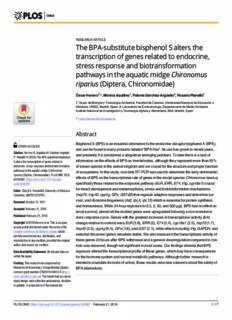
The BPA-substitute bisphenol S alters the transcription of genes related to endocrine, stress PDF
Preview The BPA-substitute bisphenol S alters the transcription of genes related to endocrine, stress
RESEARCHARTICLE The BPA-substitute bisphenol S alters the transcription of genes related to endocrine, stress response and biotransformation pathways in the aquatic midge Chironomus riparius (Diptera, Chironomidae) O´scarHerrero1*,Mo´nicaAquilino1,PalomaSa´nchez-Argu¨ello2,RosarioPlanello´1 a1111111111 1 GrupodeBiolog´ıayToxicolog´ıaAmbiental,FacultaddeCiencias,UniversidadNacionaldeEducacio´na Distancia,UNED,Madrid,Spain,2 LaboratoriodeEcotoxicolog´ıa,DepartamentodeMedioAmbiente, a1111111111 InstitutoNacionaldeInvestigacio´nyTecnolog´ıaAgrariayAlimentaria,INIA,Madrid,Spain a1111111111 a1111111111 *[email protected] a1111111111 Abstract BisphenolS(BPS)isanindustrialalternativetotheendocrinedisruptorbisphenolA(BPA), OPENACCESS andcanbefoundinmanyproductslabeled“BPA-free”.Itsusehasgrowninrecentyears, Citation:HerreroO´,AquilinoM,Sa´nchez-Argu¨ello andpresentlyitisconsideredaubiquitousemergingpollutant.Todatethereisalackof P,Planello´R(2018)TheBPA-substitutebisphenol Saltersthetranscriptionofgenesrelatedto informationontheeffectsofBPSoninvertebrates,althoughtheyrepresentmorethan95% endocrine,stressresponseandbiotransformation ofknownspeciesintheanimalkingdomandarecrucialforthestructureandproperfunction pathwaysintheaquaticmidgeChironomus ofecosystems.Inthisstudy,real-timeRT-PCRwasusedtodeterminetheearlydetrimental riparius(Diptera,Chironomidae).PLoSONE13(2): effectsofBPSonthetranscriptionalrateofgenesinthemodelspeciesChironomusriparius, e0193387.https://doi.org/10.1371/journal. pone.0193387 specificallythoserelatedtotheecdysonepathway(EcR,ERR,E74,Vtg,cyp18a1)crucial forinsectdevelopmentandmetamorphosis,stressandbiotransformationmechanisms Editor:CherylS.Rosenfeld,UniversityofMissouri Columbia,UNITEDSTATES (hsp70,hsp40,cyp4g,GPx,GSTd3)thatregulateadaptiveresponsesanddeterminesur- vival,andribosomebiogenesis(its2,rpL4,rpL13)whichisessentialforproteinsynthesis Received:October31,2017 andhomeostasis.While24-hourexposureto0.5,5,50,and500μg/LBPShadnoeffecton Accepted:February11,2018 larvalsurvival,almostallthestudiedgeneswereupregulatedfollowinganon-monotonic Published:February21,2018 dose-responsecurve.Geneswiththegreatestincreasesintranscriptionalactivity(fold Copyright:©2018Herreroetal.Thisisanopen changerelativetocontrol)wereEcR(3.8),ERR(2),E74(2.4),cyp18a1(2.5),hsp70(1.7), accessarticledistributedunderthetermsofthe hsp40(2.5),cyp4g(6.4),GPx(1.8),andGST(2.1),whileothersincludingVtg,GAPDH,and CreativeCommonsAttributionLicense,which selectedribosomalgenesremainedstable.Wealsomeasuredthetranscriptionalactivityof permitsunrestricteduse,distribution,and reproductioninanymedium,providedtheoriginal thesegenes24hoursafterBPSwithdrawalandageneraldownregulationcomparedtocon- authorandsourcearecredited. trolswasobserved,thoughnotsignificantinmostcases.OurfindingsshowedthatBPS DataAvailabilityStatement:Allrelevantdataare exposurealteredthetranscriptionalprofileofthesegenes,whichmayhaveconsequences withinthepaper. forthehormonesystemandseveralmetabolicpathways.Althoughfurtherresearchis Funding:Thisresearchwassupportedby neededtoelucidateitsmodeofaction,theseresultsraisenewconcernsaboutthesafetyof MinisteriodeEconom´ıayCompetitividad(Spain) BPAalternatives. contractgrantnumberCTM2015-64913-R(http:// www.idi.mineco.gob.es).Thefunderhadnorolein studydesign,datacollectionandanalysis,decision topublish,orpreparationofthemanuscript. PLOSONE|https://doi.org/10.1371/journal.pone.0193387 February21,2018 1/17 TheBPA-substitutebisphenolSinducestranscriptionaldisruptionintheaquaticmidgeChironomusriparius Competinginterests:Theauthorshavedeclared Introduction thatnocompetinginterestsexist. EvidencedemonstratedinrecentyearsaboutthehealthhazardsofbisphenolA(BPA)—used inplastics,receiptpaper,foodpackaging,andothermaterials—haspromptedindustriesto removethisxenobioticfromtheirproducts.RisksarebasedprimarilyontheabilityofBPAto actasanendocrine-disruptingchemical(EDC)[1],itsubiquitouspresenceintheenvironment [2],andthepotentialhazardsarisingfromcontinuousexposureofanimalsandhumans[3]. Thus,manufacturersaresubstitutingBPAwithalternativesubstances,suchasotherbisphe- nols,inanattempttocircumventinternationalrestrictions. BisphenolS(BPS)isaBPAanalogusedinavarietyofindustrialapplicationssuchaswash fasteningagentsincleaningproducts,electroplatingsolvent,andaconstituentofphenolic resin[4].Itcanalsobefoundincannedsoftdrinks,cannedfoodstuffsandthermalreceipt papers,includingproductsmarkedas“BPA-free”[5,6].Becauseofitslowerestrogenicactivity anditsgreaterstabilityagainstheatingandsunlight,BPSisconsideredasaferalternativeto BPA[7].AlthoughsomeBPA-likeeffectsarehypothesizedbecauseoftheirsimilarchemical structures,BPSispresentlyunregulatedandcanbeusedwithoutrestriction,whichhasledtoa sharpincreaseinitsproductionanduse[8].Consequently,BPShasbeendetectedindust, water,sediment,sewagesludgeandeffluentsamples[9,10],andinhumanurineandblood serum[11],atconcentrationsthataregenerallylowerthanBPA,butofthesameorderofmag- nitude[12]. WhileourunderstandingofBPStoxicityisstilllimited,availabledatasuggeststhatBPS maynotbeacompletelybenignsubstituteforBPA.IthasbeenreportedthatBPSalteredbasal testosteronesecretionbymouseandhumanfetaltestes[13].Inrodents,BPSdecreasedbody weight[14],inducedoxidativestressandmorphologicalalterationsinthemalereproductive system[15],andaffectedtranscriptionofgenesrelatedtothedopamine-serotoninsystems [16].Inzebrafish,BPSalteredtheembryonicnervousandendocrinesystems[17],and induceddevelopmentalandreproductiveabnormalities[18].Invitrostudieshavefoundthat BPSinducesmorphologicalandbiochemicalalterationsindifferenttypesofhumanblood cells,altersthemeioticcycleofporcineoocytes,andhasweakestrogenicactivity[19–21].Dif- ferentcelllineshavebeenusedtodemonstratethatBPShasestrogenicpotential,disrupts estradiol-inducedcellsignaling,modifiesgeneexpression,induceslipidaccumulationanddif- ferentiation,andalterssteroidogenesisandinhibitshormoneproduction[22–24]. Despitethefactthatinvertebratesrepresentmorethan95%ofknownspeciesintheanimal kingdomandareextremelyimportantregardingecosystemstructureandfunction,todate thereislittleinformationontheeffectsofBPSintheseorganisms.Studieswiththenematode Caenorhabditiselegansdescribedseverereproductivedefects[25]andbehavioralchanges[26] causedbyexposureto125–500μMor0.1–10μMBPS,respectively.Thelackofinformationis amajorconcern,giventhatBPSisaubiquitouspollutantthatcanbefoundinalmostanyenvi- ronmentalcompartment,isabletointeractwithnumerousinvertebratespecies,andthusmay disrupttrophicchainsandalterthenaturalbalanceofecosystems. Sincewaterusuallyconstitutesthemainvehiclefordispersionofanthropogenicpollutants, aquaticecosystemsareespeciallysensitivetotheirpresence.Aquaticinsectsareamongthe mostimportantcomponentsofafreshwaterecosystem’sbiota,andthefamilyChironomidae (Diptera)ispredominantinabundanceanddiversity.Inthisregard,Chironomusmidgeshave routinelybeenusedtoassesswaterqualitybymeansofclassicalecotoxicologicalendpoints, suchassurvival,growth,immobilization,development,andreproduction,amongothers[27]. Complementarytothosetraditionalmethods,molecularbiomarkersinChironomusripar- iusincludinggenetranscriptionandenzymeactivityhavebeendemonstratedinrecentyears tobeeffectivefortheearlydetectionofchemicaltoxicity,constitutinganimportanttime-and PLOSONE|https://doi.org/10.1371/journal.pone.0193387 February21,2018 2/17 TheBPA-substitutebisphenolSinducestranscriptionaldisruptionintheaquaticmidgeChironomusriparius cost-effectivealternativeforlarger-scaleevaluations.Thus,C.ripariuslarvaehavebeenusedto assesstranscriptionalalterationsinducedbyavarietyofpollutantsunderdifferentstresscon- ditions,andtotesttheireffectsontheactivityofenzymesinvolvedinphaseIandphaseII detoxpathways.Therehavebeenmanyeffectsrelatedtoendocrinedisruption,specificallythe ecdysonehormone,causedbyBPA,phthalates,UVfilters,biocides,metals,nonylphenol(NP), andnanoparticles(e.g.[28–31]).Furthermore,stage-andsex-dependenttranscriptionalmod- ulationofseveralecdysone-relatedgeneshasbeenreportedthroughoutC.ripariusdevelop- ment[32],andalsosomeendocrineresponsesinnaturalpopulationsexposedtocomplex mixturesofchemicals[33].Thesealterationsontheecdysonepathwaycouldultimatelyaffect otherecdysteroidssuchas20-hydroxyecdysone(20E),theactiveformoftheecdysonehor- mone,whichcontrolstheecdysis(molting)andmetamorphosisofarthropods. Theaimofthepresentstudywastodetermineforthefirsttimethetranscriptionalalter- ationsinducedinC.ripariuslarvaebyexposuretoenvironmentally-relevantconcentrationsof BPS.Thepathwaysstudiedincludetheecdysonehormonalpathway,whichplaysacentralrole duringinsectdevelopmentandmetamorphosis,severaldetoxicationandstressresponsegenes thatareinvolvedinresistancemechanismsandsurvival,anddifferentribosomalgeneswhich areimportantformaintenanceofproteinsynthesisandhomeostasis. Materialsandmethods Testanimals C.ripariuspopulationsweremaintainedatthefacilitiesoftheLaboratoryforEcotoxicologyof INIAfollowinglaboratoryconditionsdescribedbySa´nchezetal.[34].Briefly,larvaewere rearedinglassaquariawithsandsedimentandspringwaterunderstaticflowandgentle aeration,aphotoperiodof16/8hoflight/darknessandatemperatureof20±1˚C.Commercial fishfood,TetraDiscus1(530mg)wasaddedthreetimesaweekandtherearingcontainercov- eredtopreventescapeofmidges.Emergingadultswerelefttopermitmatingandoviposition. Afterremovalofadultsbyaspiration,eggropeswerecollectedandusedtoinitiatethenext generation. Treatments BPS(CASRN80-09-1;purity(cid:21)98%;Sigma-Aldrich,USA)wasdissolvedindimethylsulfoxide (DMSO;CASRN67-68-5;purity(cid:21)99.9%;Sigma-Aldrich)toobtainastocksolutionof1g/L, andstoredat−20˚C.WorkingsolutionsofBPS(0.5μg/L,5μg/L,50μg/L,500μg/L)werepre- paredfreshforeachexperimentfromthestocksolutiondilutedinculturemedium,andcon- tained0.05%DMSO.Experimentswerecarriedoutexclusivelyusingearlyphasesoffourth instarlarvae,whichweredeterminedbasedonheadcapsulewidth.Groupsof20larvaein glassvesselswereexposedto200mlofeachBPSsolutionfor24h(24hcondition).Atthesame time,fortherecoverystudies,thesameconditionsweremaintainedandafterexposure,BPS solutionswereremovedtoallowlarvaetorecover,maintainingtheminfreshculturemedium foranadditional24h(24+24hcondition).Aftereachtimepointoftheexperiment,survival valueswererecordedandfivelarvaefromeachvesselwerecollectedin1.5mlmicrotubesand frozenimmediatelyondryiceforgeneexpressionstudies.Sampleswerestoredat-80˚Cuntil RNAisolation;fourindependentexperimentswereperformed. RNAisolationandcDNAsynthesis TotalRNAwasextractedusingTRIzolReagent(Invitrogen,Germany),followingthemanu- facturer’sinstructions.Subsequently,RNAwastreatedwithRNase-freeDNase(Roche, PLOSONE|https://doi.org/10.1371/journal.pone.0193387 February21,2018 3/17 TheBPA-substitutebisphenolSinducestranscriptionaldisruptionintheaquaticmidgeChironomusriparius Germany)andextractedwithphenol:chloroform:isoamylalcohol(Fluka,Germany)using 5PRIMEPhaseLockGelLighttubes(Quantabio,USA).PurifiedRNAwasresuspendedin diethylpyrocarbonate(DEPC)water,quantifiedbyspectrophotometryat260nmusingaBio- Photometer(Eppendorf,Germany),andstoredat-80˚C. Aliquotscontaining5μgofisolatedRNAwerereverse-transcribedinaC1000Thermal Cycler(Bio-Rad,USA)usingiScriptReverseTranscriptionSupermixforRT-qPCR(Bio-Rad), accordingtothemanufacturer’sprotocol.TheobtainedcDNAwasconservedat-20˚Cand usedasthetemplateforsubsequentqPCRanalyses. Real-timeRT-PCR Quantitativereal-timeRT-PCR(qRT-PCR)wasperformedinaCFX96Real-TimeDetection System(Bio-Rad)usingtheQuantimixEasyKit(Biotools,Spain).Genesencodingactinand the26Sribosomalsubunitwereusedasendogenousreferencecontrolstoanalyzetherelative transcriptionalactivityofselectedtargetgenes:EcR,ERR,E74,Vtg,hsp70,hsp40,cyp18a1, GAPDH,cyp4g,GPx,GSTd3,its2,rpL4,andrpL13.Primersequencesandefficienciesare showninTable1.TheqRT-PCRwasrunusingthefollowingconditions:30sinitialdenatur- ationat95˚C,followedby35cyclesof5sdenaturationat95˚C,15sannealingat58˚Cand10 selongationat65˚C.Toverifytheaccuracyofeachamplicon,ameltingcurveanalysiswasper- formedafteramplification.CFXManager3.1software(Bio-Rad)wasusedtodeterminetotal mRNAlevelsbynormalizingtheexpression(2−ΔCq)ofthetargetgenesagainstthetwoendoge- nousreferencegenes.Eachsamplewasruninduplicatewells,andthreeindependentreplicates wereperformedforeachexperimentalcondition. Statisticalanalysis StatisticalanalyseswereperformedusingSPSSStatistics22software(IBM,USA).Normality andhomoscedasticityofdatawereassessedwithShapiro-Wilk’stestandLevene’stest,respec- tively.NormalizedlevelsoftranscriptswereanalyzedwithANOVA,followedbyGamesHow- ell’sorBonferroni’sposthoctests,whenappropriate.TheKruskal-Wallis’testwasusedwhen datawerenothomogeneousornormallydistributed,andthedifferencesbetweenpairswere establishedusingMann-Whitney’stests.Aprobability(P)value(cid:20)0.05wasusedasacutofffor statisticalsignificance((cid:3))ofdifferencesbetweentreatmentsandcontrolsamples. Results AfterexposureoffourthinstarC.ripariuslarvaeto0.5,5,50and500μg/LBPS,therewasno significanteffectonsurvivalrate,neitherafter24-hourcontinuousexposuretoBPSnorin 48-hourexperiments(24-hourexposureand24hofrecoveryinfreshculturemedium).Sur- vivalpercentagesarepresentedinTable2. TheresultsobtainedfromanalysisoftranscriptionalactivityofEcR,ERR,E74,andVtg(Fig 1),cyp18a1,hsp70,andhsp40(Fig2),GAPDH,cyp4g,GPx,andGSTd3(Fig3),its2,rpL4,and rpL13(Fig4)areshown.Ingeneral,24-hourexposuretoincreasingdosesofBPSledtoan invertedU-shapedoverexpressioncurveinwhichthemaximumtranscriptionalactivity appearedattheconcentrationof50μg/L,whilewithdrawalofthecompoundledtoageneral- izeddownregulation24hlater.Thispeaktranscriptionat50μg/Lwasstatisticallysignificant comparedto5μg/Land500μg/LBPS,fortheendocrineanddetoxicationgenesanalyzed. Genesencodingnuclearreceptorsweresignificantlyoverexpressedafter24hexposureto 5μg/LBPSorgreater,withmaximumlevelsreachedat50μg/LBPS,withameanincreasein transcriptionalactivityforEcRandERRof3.8-foldand2-fold,respectively(Fig1Aand1C). BothgenesweresignificantlyrepressedinalmostallconditionsafterBPSwithdrawal,falling PLOSONE|https://doi.org/10.1371/journal.pone.0193387 February21,2018 4/17 TheBPA-substitutebisphenolSinducestranscriptionaldisruptionintheaquaticmidgeChironomusriparius Table1. Primersusedforquantitativereal-timeRT-PCR. Gene Description Primer(5’!3’) Efficiency(%) 26S 26Sribosomalribonucleicacid (F) TTCGCGACCTCAACTCATGT 96.6 (R) CCGCATTCAAGCTGGACTTA actin Beta-actin (F) GATGAAGATCCTCACCGAACG 96.1 (R) CGGAAACGTTCATTACCG cyp18a1 CytochromeP45018a1 (F) GTTTCACTCGAGACGATCCA 104.5 (R) TTTAGCGGCTTGAAATGTTG cyp4g CytochromeP450family4subfamilyG (F) GACATTGATGAGAATGATGTTGGTG 101.7 (R) TAAGTGGAACTGGTGGGTACAT E74 Earlyecdysone-induciblegene (F) TCTTACTGAAACTTCTTCAAG 105.4 (R) GCTTTGAGACAGCTTTGGAAT EcR Ecdysonereceptor (F) TCTTCTCACGGCCATCGTCA 103.2 (R) GCTGCATCTTGTTTCGCCAC ERR Estrogen-relatedreceptor (F) CTCAGCAAGTAAGGAGGAG 99.4 (R) CGTCTAATAATGTGATCGG GAPDH Glyceraldehyde3-phosphatedehydrogenase (F) GGTATTTCATTGAATGATCACTTTG 103.9 (R) TAATCCTTGGATTGCATGTACTTG GPx Glutathioneperoxidase (F) AAGTGTGGTTACACAGCTAAGCATT 100.4 (R) GATATCCAAATTGATTACACGGAAA GSTd3 GlutathioneS-transferaseD3 (F) TGGTTGAAACGAGAGCACCA 109.3 (R) TCGGATATAGAGTGCCAGCATCG hsp40 40kDaheat-shockprotein (F) TACGTGACGCTAGAGGAAA 108.1 (R) TTCCAGCCCGGCTT hsp70 70kDaheat-shockprotein (F) ACTTGAACCAGTTGAGCGT 102.8 (R) TTGCCACAGAAGAAATCTTG its2 Internaltranscribedspacer2 (F) TCATCAAAGCCGTTGTCT 97.2 (R) AATCGAATTGCAAACACC rpL4 RibosomalproteinL4 (F) AACGCTTCAGAGCTGGACGTGG 110.7 (R) ATTCATCTTGTGTACGCTCATTG rpL13 RibosomalproteinL13 (F) AAGCTGCTTTCCCAAGAC 103.3 (R) TTGGCATAATTGGTCCAG Vtg Vitellogenin (F) GATTGTTCCATGTGCAG 96.8 (R) TTTGAGTATGGTGGAGAATC https://doi.org/10.1371/journal.pone.0193387.t001 tovalues70%lowerthancontrols(Fig1Band1D).Similarly,theexpressionprofileofE74had apeakafterexposureto50μg/LBPS(2.4-fold)(Fig1E)andageneraldownregulationafter24 hrecovery(upto80%lessthancontrol)(Fig1F).However,inthiscasedownregulationwas notsignificantexceptatthelowestBPSconcentrationtested.Moresubtlechangeswere observedforVtg,whichdidnotexhibitstatisticalsignificanceinanyoftheexperimentalcon- ditions(Fig1Gand1H). Table2. EffectofBPSonthesurvivalrate(%)ofC.ripariuslarvae(n=80)(mean±SD). BPSconcentration[μg/L] Control 0.5 5 50 500 24h 100±0.00 100±0.00 96.67±2.89 100±0.00 95±5.00 24+24h 91.67±8.33 100±0.00 88.64±12.65 94.44±4.81 88.89±19.25 https://doi.org/10.1371/journal.pone.0193387.t002 PLOSONE|https://doi.org/10.1371/journal.pone.0193387 February21,2018 5/17 TheBPA-substitutebisphenolSinducestranscriptionaldisruptionintheaquaticmidgeChironomusriparius Fig1.TranscriptionalactivityofEcR,ERR,E74,andVtg.Box-and-whiskerplotsrepresenttheexpressionpatternsofEcR(A-B),ERR (C-D),E74(E-F),andVtg(G-H),measuredbyreal-timeRT-PCR.C.ripariusfourthinstarlarvaewereexposedto0.5–500μg/LBPSfor 24h(24h;leftcolumn;blueseries),andmaintainedforanadditional24hinfreshculturemediumafterBPSwithdrawal(24+24h;right column;greenseries).FourindependentexperimentswereperformedandRNAwasextractedfrom5larvaeforeachexperimental condition(n=20).Resultswerenormalizedtocontrolvalues.Boxandwhiskersrepresentthe25–75percentileandtheminimum/ PLOSONE|https://doi.org/10.1371/journal.pone.0193387 February21,2018 6/17 TheBPA-substitutebisphenolSinducestranscriptionaldisruptionintheaquaticmidgeChironomusriparius maximummeasuredvalues;themeanisrepresentedbyadot;thehorizontallineseparatingthelower(dark)andtheupper(light)area representsthemedian.Asterisks((cid:3))indicatesignificantdifferences(p(cid:20)0.05)withrespecttocontrolvalues. https://doi.org/10.1371/journal.pone.0193387.g001 Fig2.Transcriptionalactivityofcyp18a1,hsp70,andhsp40.Box-and-whiskerplotsrepresenttheexpressionpatternsofcyp18a1(A-B),hsp70(C-D), andhsp40(E-F),measuredbyreal-timeRT-PCR.C.ripariusfourthinstarlarvaewereexposedto0.5–500μg/LBPSfor24h(24h;leftcolumn;blue series),andmaintainedforanadditional24hinfreshculturemediumafterBPSwithdrawal(24+24h;rightcolumn;greenseries).Fourindependent experimentswereperformedandRNAwasextractedfrom5larvaeforeachexperimentalcondition(n=20).Resultswerenormalizedtocontrolvalues. Boxandwhiskersrepresentthe25–75percentileandtheminimum/maximummeasuredvalues;themeanisrepresentedbyadot;thehorizontalline separatingthelower(dark)andtheupper(light)arearepresentsthemedian.Asterisks((cid:3))indicatesignificantdifferences(p(cid:20)0.05)withrespectto controlvalues. https://doi.org/10.1371/journal.pone.0193387.g002 PLOSONE|https://doi.org/10.1371/journal.pone.0193387 February21,2018 7/17 TheBPA-substitutebisphenolSinducestranscriptionaldisruptionintheaquaticmidgeChironomusriparius Fig3.TranscriptionalactivityofGAPDH,cyp4g,GPx,andGSTd3.Box-and-whiskerplotsrepresenttheexpressionpatternsof GAPDH(A-B),cyp4g(C-D),GPx(E-F),andGSTd3(G-H)measuredbyreal-timeRT-PCR.C.ripariusfourthinstarlarvaewereexposed to0.5–500μg/LBPSfor24h(24h;leftcolumn;blueseries),andmaintainedforanadditional24hinfreshculturemediumafterBPS withdrawal(24+24h;rightcolumn;greenseries).FourindependentexperimentswereperformedandRNAwasextractedfrom5larvae foreachexperimentalcondition(n=20).Resultswerenormalizedtocontrolvalues.Boxandwhiskersrepresentthe25–75percentile PLOSONE|https://doi.org/10.1371/journal.pone.0193387 February21,2018 8/17 TheBPA-substitutebisphenolSinducestranscriptionaldisruptionintheaquaticmidgeChironomusriparius andtheminimum/maximummeasuredvalues;themeanisrepresentedbyadot;thehorizontallineseparatingthelower(dark)andthe upper(light)arearepresentsthemedian.Asterisks((cid:3))indicatesignificantdifferences(p(cid:20)0.05)withrespecttocontrolvalues. https://doi.org/10.1371/journal.pone.0193387.g003 Fig4.Transcriptionalactivityofits2,rpL4,andrpL13.Box-and-whiskerplotsrepresenttheexpressionpatternsofits2(A-B),rpL4(C-D),andrpL13 (E-F),measuredbyreal-timeRT-PCR.C.ripariusfourthinstarlarvaewereexposedto0.5–500μg/LBPSfor24h(24h;leftcolumn;blueseries),and maintainedforanadditional24hinfreshculturemediumafterBPSwithdrawal(24+24h;rightcolumn;greenseries).Fourindependentexperiments wereperformedandRNAwasextractedfrom5larvaeforeachexperimentalcondition(n=20).Resultswerenormalizedtocontrolvalues.Boxand whiskersrepresentthe25–75percentileandtheminimum/maximummeasuredvalues;themeanisrepresentedbyadot;thehorizontallineseparating thelower(dark)andtheupper(light)arearepresentsthemedian.Asterisks((cid:3))indicatesignificantdifferences(p(cid:20)0.05)withrespecttocontrolvalues. https://doi.org/10.1371/journal.pone.0193387.g004 PLOSONE|https://doi.org/10.1371/journal.pone.0193387 February21,2018 9/17 TheBPA-substitutebisphenolSinducestranscriptionaldisruptionintheaquaticmidgeChironomusriparius Transcriptionalactivityofcyp18a1wassignificantlyupregulatedfrom0.5μg/LBPSand reacheditsmaximum(2.5-foldincrease)at50μg/LBPS(Fig2A).WithdrawalofBPSledtoa generalreductionofactivity(50%lessthancontrol),whichwasstatisticallysignificantatthe highestdose(500μg/L)(Fig2B).Thetwogenesencodingheatshockproteinshadincreased expressionlevelsinthepresenceofBPS,althoughtheyshowedadifferentialresponse.While hsp40showedsignificantdifferencesabove5μg/LBPS(Fig2E),similartoothergenesinthis study,hsp70showedanegative,lineardose-response,withsignificantdifferencesonlyatthe twolowestdoses(Fig2C).BothgenesweredownregulatedafterBPSwithdrawal(upto60% less)(Fig2Dand2E),withhsp40significantlylowerthanthecontrolatallconcentrations(Fig 2E). GAPDHremainedunalteredunderalltheexperimentalconditions(Fig3Aand3B).How- ever,genesinvolvedinbiotransformationactivities(cyp4g,GPx,andGST)showedsimilar responsestothoseobservedforEcR,ERR,cyp18a1,andhsp40,withsignificantoverexpression after24hexposureto5μg/LBPSandamaximumvalueat50μg/L(6.4-fold,1.8-fold,and 2.1-fold,respectively)(Fig3C,3Eand3G).AllthesegeneswerealsorepressedafterBPSwith- drawal,althoughourresultsdidnothavesignificantdifferences(Fig3D,3Fand3H). Ribosomalgenesremainedfairlystable,althoughsomeeffectswereobserved.Thelowest BPSdose(0.5μg/L)causedadropintranscription,significantforits2andrpL4(about25% belowcontrols)(Fig4Aand4C).Onthecontrary,andsimilartothatobservedforothergenes (althoughwithoutstatisticalsignificance),maximumtranscriptionwasobservedafterexpo- sureto50μg/LBPS(Fig4A,4Cand4E).AfterrecoveryfollowingBPSremoval,bothits2and rpL4wererepressed(Fig4Band4D),whilerpL13showedariseinitstranscriptionrate(upto 2-fold)thatwasnotsignificantduetodatavariability(Fig4F). Discussion ManyworksinrecentyearshaverevealedthedangerousnatureofBPA,notonlyregarding hormonalalterationanditsimplicationinreproductionanddevelopment,butalsoother healthdisorderssuchasbreastcancer,obesity,type-2diabetes,oxidativestress,neurodevelop- ment,asthma,andcardiovasculardiseases[1].Withthisevidence,andthankstodifferent socialandlegalpressures,industrieshavegraduallyreplacedBPAwithalternativesincluding structuralanalogssuchasbisphenolsAF,AP,B,E,F,P,S,orZ.Thisreplacementhasbeencar- riedoutwithoutstrictadherencetothe“precautionaryprinciple”,whichshouldbeusedwhen preliminaryscientificevidenceindicatesthattherearereasonableconcernsaboutpotentially dangerouseffectsontheenvironmentorhuman,animalorplanthealth[35].Thus,asmore scientificstudiesshowadverseeffectsofthesechemicalalternatives[8,13,36],itmaybejustas riskytobuyaproductlabeled"BPA-free"asoptingforthosecontainingBPA. Theobjectiveofthepresentworkwastoshedlightonthepossibleadverseenvironmental effectsofBPS,aBPAanaloguecommonlyusedin"BPA-free"products.Ourexperimentswere carriedoutwithaquaticlarvaeofC.ripariusmidges,averyrelevantspeciesinaquaticecosys- temsusedinstudiesonecotoxicityofwaterandsediments,andespeciallysuitableforrisk assessmentsofpotentialendocrine-disruptingpropertiesofchemicals[37,38].Forthispur- pose,weselectedBPSconcentrationsrangingfrom0.5to500μg/L,wherethelowestdosesare ofthesameorderofmagnitudeasthosedetectedinnaturalenvironments,wastewater,and theurineofexposedpopulations.Somemeanmaximumconcentrationsreportedinaquatic environmentsare0.16and1.6μg/LforTaihuLake(China)[39,40],and7.2μg/LforAdyar River(India)[41].Sunetal.[10]reportedvaluesrangingfrom0.183–0.746μg/L(influent)ina wastewatertreatmentplantinChina.UrinesamplesfromJapan,USA,andChinacontained 0.933,0.304,and0.223μg/mlBPS,respectively[42].BPSispersistentinsedimentsandmore PLOSONE|https://doi.org/10.1371/journal.pone.0193387 February21,2018 10/17
Description: